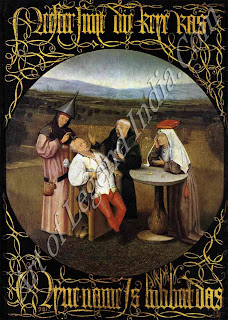 Nightmare Visions
Nightmare Visions Netherlandish Great Artist Hieronymus Bosch - Nightmare Visions
Posted by
Art Of Legend India [dot] Com
On
11:55 PM
 Nightmare Visions
Nightmare Visions
Bosch's
often macabre symbolism can seem obscure today. But in his time, his creations
taking giant artistic leaps thanks to his intricate imagination were understood
as highly moral tales.
'Spectres
and apparitions of Hell' is how one 16th-century poet described the content of
Bosch's terrifying visions. His grotesque hybrids of birds, beast and man
inhabit a phantasmagoric world, where demons contend for the souls of men, and
where evil is ever-present. As fascinating as it is disturbing, Bosch's
strange, enigmatic art reveals man in all his depravity, sorely tempted by sin,
and destined for damnation.
Though
Bosch clearly possessed a powerful imagination, his works are never fanciful.
However fabulous they appear, his subjects are rooted in what Bosch and his
contemporaries considered to be reality the reality of man's sinfulness and
depravity. Even in his most fantastic paintings Bosch maintains a fine eye for
natural representation. His monstrous birds, although strange, hybrid creatures
are based on detailed observation. And there is a moral intensity about his
work that makes him more than a painter of the fantastic. A 16th-century
collector said that Bosch's subject matter was 'the habits and passions of the
soul of man.'
In its
subject matter, his art is quite different from mainstream 15th-century Flemish
painting. Whereas his contemporaries usually adhered closely to traditional,
biblical themes, and used conventional imagery, Bosch was more adventurous. In
his mature work, particularly, he took images from a variety of sources
alchemy, magic, witchcraft, astrology, and mysticism to explore the darker
areas of the human psyche and to visualize the torments that await the sinner
in the next world: humiliation, fear and torture.
In the
catalogue of folly depicted in his paintings, Bosch provides a black satire on
the human condition in all its moral frailty. To do this he often drew on the proverbs
and folklore of his day, on 14th-century moralistic writings, or on
contemporary satire such as Sebastian Brant's poem, The Ship of Fools (1494).
These provided him with useful images which could be directed against mankind's
numerous vices. Licentiousness, gluttony, avarice and pride, all fall under his
stick. Bosch was essentially a moralist and his bizarre representations teach a
stern lesson.
His
style was also out of the mainstream. While most contemporary painters worked
in the tradition of Van Eyck and Van der Weyden using a slow and painstaking
technique in order to render forms as realistically as possible, Bosch worked
quickly often without revision to achieve dream-like effects.
The
Flemish painter and art historian Karel van Mander described Bosch's technique
as follows: 'He had a manner of sketching and drawing objects directly on the
white ground of the panel and laying over them a transparent, flesh-coloured
prime coat. This meant that frequently the undercoat would contribute to the
final effect of the painting.' Very often, the paint is applied so thinly that
the black chalk drawing beneath is discernible. Highlights, in the form of
little flecks of bright colour, were also applied quickly, adding to the lively
effect.
That
Bosch was a fine draughtsman is clear from the drawings and sketches by him
that have survived. These were executed in ink using pen and brush, and amount
to no more than 30 sheets. Many of these contain sketches of beggars, cripples
and monsters intended as preparatory studies for his paintings. These lively
drawings were executed quickly and with characteristic vigour.
Bosch's
works also display a highly developed sense of drama. Vigorous actions,
exaggerated poses and intense facial expressions (often in profile)
characterize many of his paintings, where outer conflict parallels inner
turmoil. And even in his quieter studies, disturbing undercurrents are
apparent. Bosch was a master of the grotesque and often used caricature to
reveal man at his most malevolent.
It is a
difficult task to trace the development of Bosch's style. None of his paintings
are dated, and there is little documentary evidence to establish chronology or
even authenticity Bosch had many imitators.
His
early work has an archaic quality which shows close affinities with Dutch panel
paintings of the late 14th, early 15th centuries and also with early Dutch and
German woodcuts and copperplate engravings. Similarly, his biblical paintings
echo the work of Dutch manuscript illuminators of the first half of the 15th
century in their high horizons, and in the elements of everyday life which he
often incorporated into his religious narratives. The most bizarre example of
this, perhaps, is his depiction of the Christ Child supporting himself by means
of a 15th-century walking frame.
Although
some of Bosch's earlier works seem little more than genre paintings, even these
possess an unorthodox symbolism which clearly distinguishes them from the
conventional. In The Cure of Folly, for example, a nun balances a book on her
head, while a charlatan wears a funnel. And his early themes the foolishness of
man, the wily machinations of the Devil and the lusts of the flesh foreshadow
those which were to receive fuller expression in his greatest works. These
early paintings, however, lack finesse his brushwork is limited, his figures
are flat and relatively heavy, and the arrangement of his figures is awkward.
In the
1480s and 1490s, there is a movement towards a more complex symbolism. In The
Hay Wain, what at first sight is a rural genre scene, depicting a hay wagon and
reveling haymakers, is transformed by Bosch into a vast religious sequence,
showing the Fall of Man, his earthly existence and lest he mend his ways his
ultimate descent into Hell. Though the subject originates from the traditional
Flemish saying 'The world is a waggon of hay, everyone grabs what he can',
Bosch uses the proverb as a springboard for his imaginative genius. Images of
bestiality and barbarity abound as all kinds of monstrous combinations pour
into his horrific scenarios. The earthly world is portrayed as seductive but
treacherous, leading those who succumb to its transient delights to perdition.
The torments of Hell that await them are horrifyingly vivid.
The
monsters of Bosch's paintings no doubt derive from a variety of sources
including the marginal drolleries of illuminated manuscripts, and even perhaps
the gargoyles which straddle church in Hertogenbosch. Though these composite
creatures are baffling and in 20th-century terms, they appear 'surreal' - the
moral point Bosch is making by using them is far from ambiguous: those who
devote themselves to the pleasures of this life will see such brief joys
'transformed into eternal wrath, with no hope'.
Although
Bosch's pessimism is daunting, paradise is not unattainable, at least not for
those who devote their lives to God. A number of his paintings deal with the
theme of the religious hermit, who struggles against the temptations of earthly
existence so that he might win a place in heaven. Stories of the saints were
popular in the middle Ages, and recounted in such works as the Golden Legend
(or Legends of the Saints) written by Jacobus de Voragine (c.1260). The saints'
battle with the forces of evil is clearly a subject that fascinated Bosch, as
his depictions of St Anthony and St John suggest. The Temptation of St Anthony
is packed with incidents from the legend.
Bosch's
sensitive and skilful treatment of landscape can be seen in the beautiful
panoramic view that forms the backdrop to St John the Baptist in the
Wilderness. Sharp details in the foreground give way to soft gradations of
green and blue in the mountains behind. Bosch's response to the landscape of
his native country was immediate, and influential.
In his
later works, from 1500 onwards, Bosch shows a complete mastery over his
singular technique. In The Garden of Earthly Delights, his colours assume a
luminous, precious quality, which makes the sins depicted appear particularly
attractive. It is the dream-like beauty of such works which has led to a
misinterpretation of Bosch's intent. By making sin visually appealing, he
depicts the nature of its seductiveness. But this is certainly not an
indication that Bosch 'approves' of the promiscuity which occurs in the central
panel of The Garden, for example. The bizarre horrors of the right-hand panel
are his idea of the consequences of the activities shown in the centre.
Bosch's
art is an expression of orthodox Catholicism, as the popularity of his
paintings in that most Catholic of environments 16th-century Spain attests. His
paintings were highly valued by Phillip II. That his works are also unique,
however, is also beyond question. According to a Spanish priest of the 17th
century, this uniqueness lay in the fact that whereas other painters painted
'man as he is on the outside,' Bosch had the 'audacity to paint him as he is on
the inside.' This audacity is responsible for some of the most original
paintings the world has ever known.
Writer
– Marshall Cavendish
Subscribe to:
Post Comments (Atom)

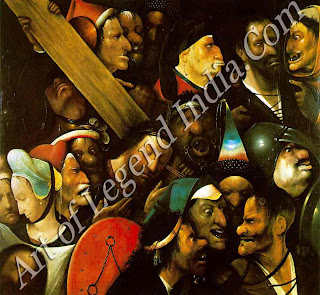
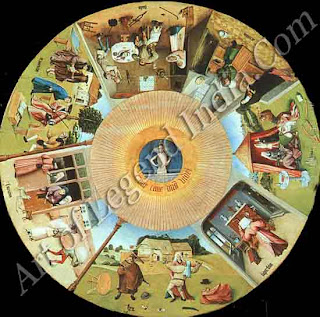

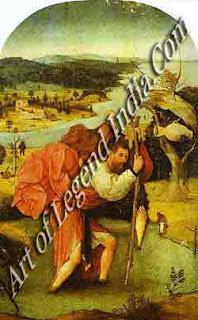
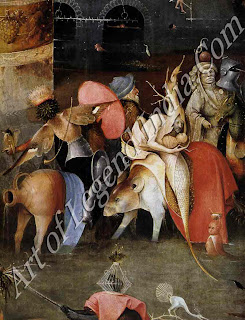
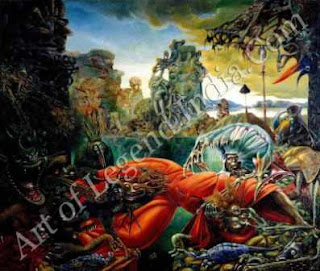










0 Response to "Netherlandish Great Artist Hieronymus Bosch - Nightmare Visions "
Post a Comment